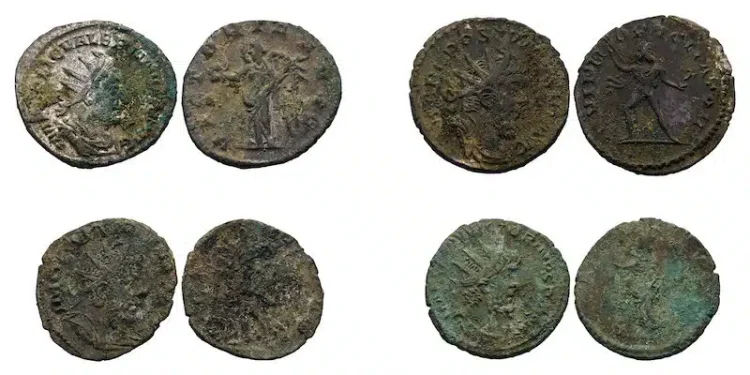At the peak of its power, the Roman Empire stood unmatched in cultural, military, and political influence, stretching across three continents by 117 C.E. Yet, recent discoveries continue to shed new light on this ancient superpower’s reach and interactions. In a fascinating turn of events, a hoard of Roman-era coins was unearthed in Herschbach, Germany, an area far removed from Roman borders and known Germanic settlements. This finding raises compelling questions about the circumstances that led to their burial in such an unexpected location.
Discovery of the Hidden Treasure
This Article Includes

The remarkable hoard was uncovered by a licensed metal detectorist exploring the outskirts of Herschbach, nestled in Germany’s Westerwald mountains. Following this discovery, government archaeologists conducted an extensive excavation, recovering nearly 3,000 Roman coins along with over 200 decorative silver fragments. These treasures were found encased in a ceramic pot, carefully lodged between two rocks—a testament to the effort taken to hide them.
Also Read: Upcoming Changes in Social Security Payments: What Beneficiaries Should Expect for November and 2025
Dating the Coins: A Glimpse Into the Past
While the coins’ poor preservation has made identification a meticulous process, preliminary analyses have provided a crucial timeline. Of the 100 coins identified so far, the oldest feature Emperor Gordianus III, who ruled between 238 and 244 C.E. The most recent depict Victorinus, a Gallic emperor from approximately 269 to 271 C.E. Based on these findings, archaeologists estimate that the coins were buried in the early 270s.
An Enigmatic Location

What makes this discovery particularly intriguing is its geographic context. The site lies miles beyond the Roman Empire’s borders, far from any known settlements of Germanic tribes. This raises the question: why would such a substantial hoard be hidden in enemy territory? Scholars speculate that the coins may have been used as bribes by the Gallic Empire to secure peace with Germanic elites. Another possibility is that the hoard represents trade with Germanic leaders or local Roman sympathizers. However, the exact circumstances remain a mystery.
Challenges in Preservation and Research
The condition of the artifacts poses a significant challenge to researchers. Many of the coins and fragments have suffered extensive deterioration over time, complicating efforts to identify and analyze them. Despite these obstacles, archaeologists are determined to uncover the full story behind this find, as each coin offers a glimpse into the economic and political dynamics of the era.
Broader Implications of the Find
This discovery is not only a treasure trove of ancient artifacts but also a doorway to understanding cross-border interactions during the third century. The period was marked by instability, including the fragmentation of the Roman Empire and the rise of the Gallic Empire. Insights gleaned from these coins could provide valuable information on diplomacy, conflict, and trade in a tumultuous era.
Also Read: Double Social Security Payments in November 2024: Here’s What You Need to Know
Conclusion: A Puzzle for the Ages
The Herschbach hoard offers a tantalizing mystery. Who buried these coins, and why did they choose such a remote location? As researchers continue their meticulous work, this extraordinary find may eventually unravel some of these questions. For now, it stands as a testament to the enduring allure of uncovering history’s secrets—hidden beneath the soil and waiting to be rediscovered.
